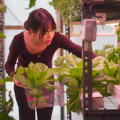A University of Queensland researcher is applying human medical techniques to soil in a project likely to save sugar producers money and help protect the Great Barrier Reef.
UQ PhD scholar Richard Brackin’s work, using a new technology for non-invasive micro-scale soil sampling, promises to change how cane growers fertilise their crops.
It is likely to lead to significant reductions in fertiliser use without reducing crop quality or yield, and would lead to reduced nitrogen run-off to the Great Barrier Reef.
The research has received a $22,000 boost thanks to a Sugar Research and Development Corporation Young Science and Innovation Award.
“Micro-dialysis is an established medical and neurological technique, but has only recently been applied to soil,” he said.
“It has the potential to improve understanding of nutrient availability at the soil-root interface, as micro-dialysis is able to measure ‘flux rates’, or up-take of nutrients by plant roots.”
The Young Science and Innovation Award judges said Richard’s work would deliver economic, environmental and social benefits for the sugarcane industry, and had positive implications for climate change, the environment (especially the Great Barrier Reef) and grower production costs.
Richard said current soil-sampling methods provided only a snapshot of nutrient levels at a particular time, based on the manual extraction of soils.
“Micro-dialysis monitors changes in nitrogen fertiliser after it has been applied to soil, by providing high-resolution real-time measurements of nitrogen fluxes and turnover at a micro-scale,” he said.
“Positioning micro-dialysis membranes in close proximity to sugarcane roots will allow more detailed analysis of the rapid nitrogen transformations that occur after fertiliser application in sugarcane soil, can measure the preferential uptake of particular forms of nitrogen by roots.
“This technique is highly innovative and generates data that cannot be produced using current soil techniques,” he said.
Sugarcane is one of the least-efficient crops in terms of nutrient up-take, and scientists estimate that sugarcane crops acquire only about 50 per cent of applied nitrogen fertiliser.
Fertiliser is largely applied as a single application of urea, but soil microbes rapidly transform this into different nitrogen forms.
“The resulting rapid fluxes of each nitrogen pool make quantification difficult using traditional methods, and this knowledge gap contributes to difficulty matching nitrogen supply to plant demand,” Richard said.
“As a result, fertiliser inputs generally exceed crop use, which means the grower is wasting money, and run-off could damage the environment.
Richard hopes his research will help growers to improve their nutrient-use efficiency through better knowledge of nitrogen dynamics.
It will save growers money and help them meet Queensland Government regulations on nitrogen application under the Reef Protection Scheme.
“The outcome of my research will assist grower decision-making about what fertiliser types to use, application rates and timing,” he said.
The research will include two main components: field sampling in three sugarcane regions, at Jacob’s Well in Southern Queensland, Bundaberg in the Wide Bay region, and in The Burdekin in North Queensland, followed by laboratory experiments to examine a larger range of environmental conditions and interaction with sugarcane plants.
The Sugar Research and Development Corporation Young Science and Innovation Award means Richard will get $22,000 over the next 12 months for his Unlocking soil secrets: micro-dialysis of the soil-plant interface to improve fertiliser use and reduce pollution research.
Minister for Agriculture, Fisheries and Forestry Senator Joe Ludwig presented the award in Canberra.
Media: Richard Brackin, 0401 196 496, r.brackin@uq.edu.au.
UQ Communications Carolyn Varley, (+61) 7 3365 1120 or 0413 601 248, c.varley@uq.edu.au.
SRDC Communications Carolyn Martin (+61) 7 3210 0495 or 0439 399 886, cmartin@srdc.gov.au.
.jpg)












